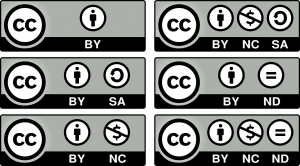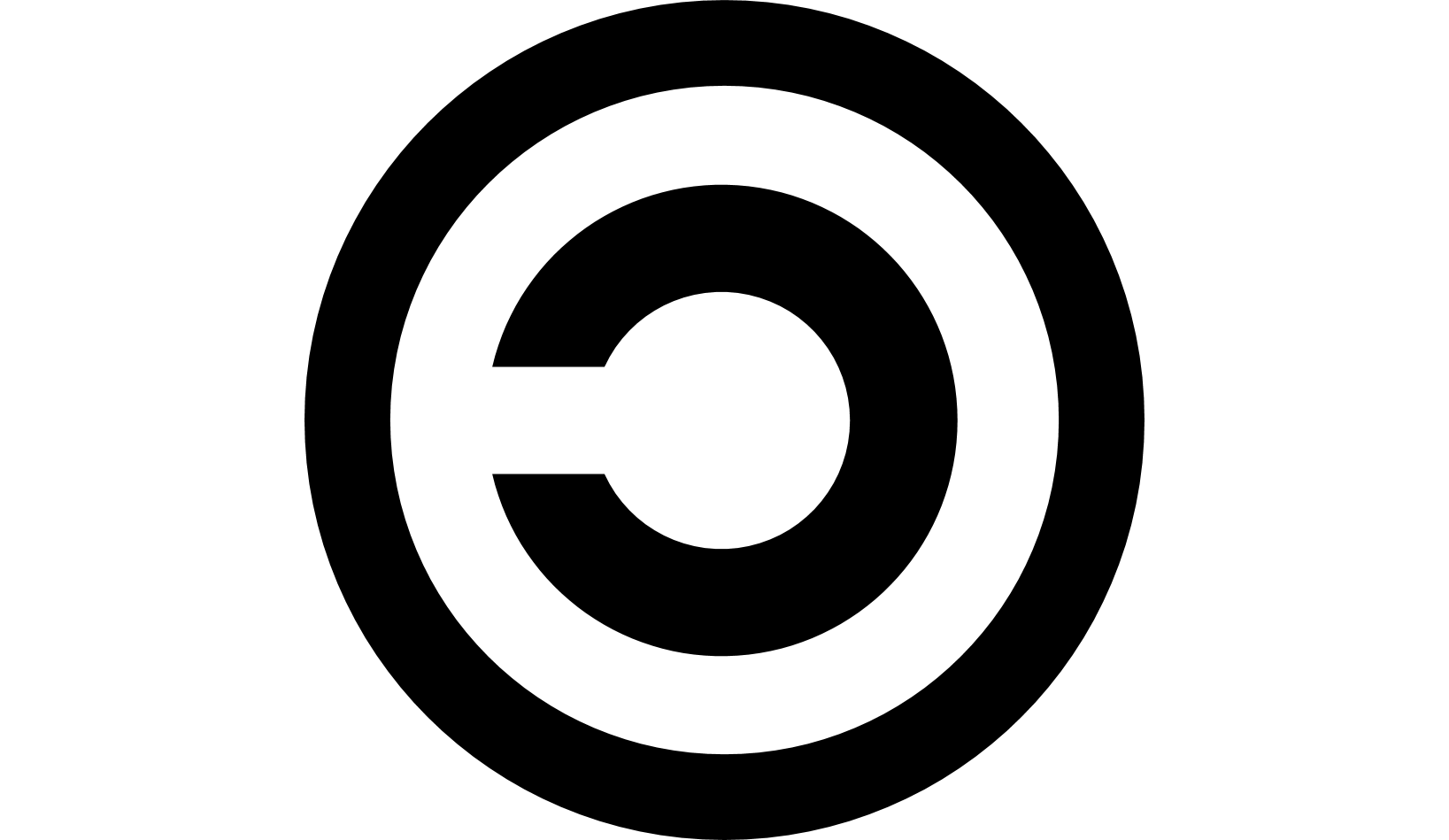Copyright – Creative Commons – License – Attributions
Works are original when they are independently created by a human author and have a minimal degree of creativity. Independent creation simply means that you create it yourself, without copying. The Supreme Court has said that, to be creative, a work must have a “spark” and “modicum” of creativity. There are some things, however, that are not creative, like: titles, names, short phrases, and slogans; familiar symbols or designs; mere variations of typographic ornamentation, lettering, or coloring; and mere listings of ingredients or contents. And always keep in mind that copyright protects expression, and never ideas, procedures, methods, systems, processes, concepts, principles, or discoveries.[1]
Copyright and Creative Commons
Using a Creative Commons license does not negate copyright — it modifies the terms of copyright, allowing others to use a work with attribution, that is, while recognizing the intellectual property of the copyright holder(s). As Creative Commons states, “CC licenses are copyright licenses, and depend on the existence of copyright to work. CC licenses are legal tools that creators and other rights holders can use to offer certain usage rights to the public, while reserving other rights.”
The video below discusses how Creative Commons licenses allow creators to modify copyright terms.
Creative Commons Kiwi from Creative Commons Aotearoa New Zealand is used under a CC BY 3.0 NZ license.
Choose a license
If you are adapting an existing open textbook, the adaptations you make will be released with whatever open licence you choose, while the rest of the book will be released under the licence of the original book. In other words, you need to respect the licence of the original work. You cannot license what you do not create. You can only attach a CC BY (Creative Commons Attribution) or other open licence to the parts of the book that you have created and that are new.
However, there is a “catch.” If the textbook you are adapting has a ShareAlike condition (CC BY-SA 4.0) stipulated, then you must release the entire book using the same licence as the original book.
Below are the symbols and definitions of each of the Creative Commons licences. If you are unsure which CC licence you would like to use, you can use the Creative Commons Choose a License tool.

Attribution: CC BY 
This license lets others distribute, remix, tweak, and build upon your work, even commercially, as long as they credit you for the original creation. This is the most accommodating of licenses offered. Recommended for maximum dissemination and use of licensed materials.
Attribution-ShareAlike: CC BY-SA 
This license lets others remix, tweak, and build upon your work even for commercial purposes, as long as they credit you and license their new creations under the identical terms. This license is often compared to “copyleft” free and open source software licenses. All new works based on yours will carry the same license, so any derivatives will also allow commercial use. This is the license used by Wikipedia, and is recommended for materials that would benefit from incorporating content from Wikipedia and similarly licensed projects.
Attribution-NoDerivs: CC BY-ND 
This license allows for redistribution, commercial and non-commercial, as long as it is passed along unchanged and in whole, with credit to you.
Attribution-NonCommercial: CC BY-NC 
This license lets others remix, tweak, and build upon your work non-commercially, and although their new works must also acknowledge you and be non-commercial, they don’t have to license their derivative works on the same terms.
Attribution-NonCommercial-ShareAlike: CC BY-NC-SA 
This license lets others remix, tweak, and build upon your work non-commercially, as long as they credit you and license their new creations under the identical terms.
Attribution-NonCommercial-NoDerivs: CC BY-NC-ND 
This license is the most restrictive of our six main licenses, only allowing others to download your works and share them with others as long as they credit you, but they can’t change them in any way or use them commercially.
Attributions
The Creative Commons license definitions and images listed on this page have been copied from Creative Commons and are used under a CC BY 4.0 license.
Alternative licenses
While Creative Commons licensing is a well-recognized, straight-forward, flexible type of licensing that is strongly associated with OER, there are other types of open licensing available.
GNU
![]()
The GNU General Public License is a “free, copyleft license for software and other kinds of works.”
Copyleft

Copyleft is comparable to the ShareAlike aspect of a Creative Commons license.
Public Domain

Works in the public domain are not copyrighted. Different countries have different copyright laws and lengths, however, which must be carefully checked.
Creative Commons has public domain tools that allow users to place their works in the public domain.
Attributions
The GNU General Public License version 3 logo is in the Public Domain.
The Copyleft symbol by Zscout370 is in the Public Domain.
The Public Domain logo has been copied from Creative Commons and is used under a CC BY license.
Combining CC licenses
When adapting an open textbook (or other OER), you may want to incorporate other people’s works into your adaptation. In order to do that, you must ensure that any existing licences on the work you’re adapting or including are compatible with each other.
For example, as explained in the chapter on Creative Commons licensing, the CC BY licence is the least restrictive and is compatible with all of the other CC licences. However, if you want to include a work that has a CC BY-SA licence, you must use that same licence with your adaptation (which may conflict with other licences already attached to the work). Creative Commons provides more information about CC BY-SA licence compatibility.


The Orange Grove repository’s video below further explains how CC licenses can be combined.
https://youtube.com/watch?v=Hkz4q2yuQU8%3Fecver%3D2
For further help, you can use the use the Creative Commons Choose a License tool or the Wiki/cc license compatibility chart, or contact your institution’s Library or Teaching & Learning Centre.
Attribution
The Creative Commons licence definitions and images listed on this page have been copied from Creative Commons and are used under a CC BY 4.0 licence.
Attributions
Regardless of the Creative Commons license you choose for your OER, all CC licenses require at least an attribution to the original creator of the work (the “BY” part of a CC license). Below are some examples of how to create attribution statements for text and media.
This attribution builder from Open Washington can also be a useful tool. Creative Commons also has best practices for attribution.
Examples of attribution statements
All Creative Commons licenses contain an attribution (BY) clause. This means that you must include a statement that gives credit to, or attributes, the creator of the work from which you have borrowed, whether it’s text, an image, a video, or other item. If you have made a change, indicate that in your attribution statement.
As far as how and where to place attribution statements for text or media taken from another source or sources, best practices state that you should place them at the bottom of each affected web page. Clearly mark all of these with a heading called: “Attributions”. Several attribution statements can be listed under this heading. Here are examples.
Example of an attribution statement for adapted text
This chapter is an adaptation of Natural Disasters and Human Impacts (on Open Geography Education) by R. Adam Dastrup and Maura Hahnenberger, and is used under a CC BY-SA 4.0 International license.
Note:
- The statement is clear, simple, and contains all elements required for a complete attribution: title of the work used, author(s), and license type. A link is provided to the original work, the home page of the website (this is optional), and the license type.
- There is no need to name the adapting author in this statement. This information should either be included on the Book Info page as a main author OR if you want to indicate which author wrote/adapted which chapter, you can use the Chapter Author option at the bottom of each chapter/web page in Pressbooks.
- If the book is to be CC BY licensed, then you will need to address the conditions dictated by the license for each resource you are using in your adaptation. At the bottom of the Chapter page in Pressbooks, there is an option to set the license type for that page which will override, for this page only, the overarching license chosen for the book on the Book Info page.
- If the chapter contains some original material AND some material from another source, then rather than saying “This chapter is an adaptation of….”, say “This chapter contains material taken from….”.
Example of an attribution statement for an adapted image
Figure 1.2
Dog by David Locke is used under a CC BY 2.0 license. Modifications to this photo include cropping.
Note:
- The statement is clear, simple and contains all elements required for a complete attribution: title of the image, photographer, and license type, as well as a note of the changes made. A link is provided to the original work, the home page of the photographer (if available), and the license type.
Attributions
This chapter contains material from the BCcampus Open Education Adaptation Guide by BCcampus and is used under a CC BY 4.0 International License. Download this book for free at http://open.bccampus.ca.
Media Attributions
- CC BY
- CC BY-SA
- CC BY-ND
- CC BY-NC
- CC BY-NC-SA
- CC BY-NC-ND
- Copyleft
- CC0 mark
- CC BY compatibility
- CC BY-NC compatibility
- What is copyright? U.S. Copyright Office. (n.d.). Retrieved October 12, 2022, from https://www.copyright.gov/what-is-copyright/ ↵
